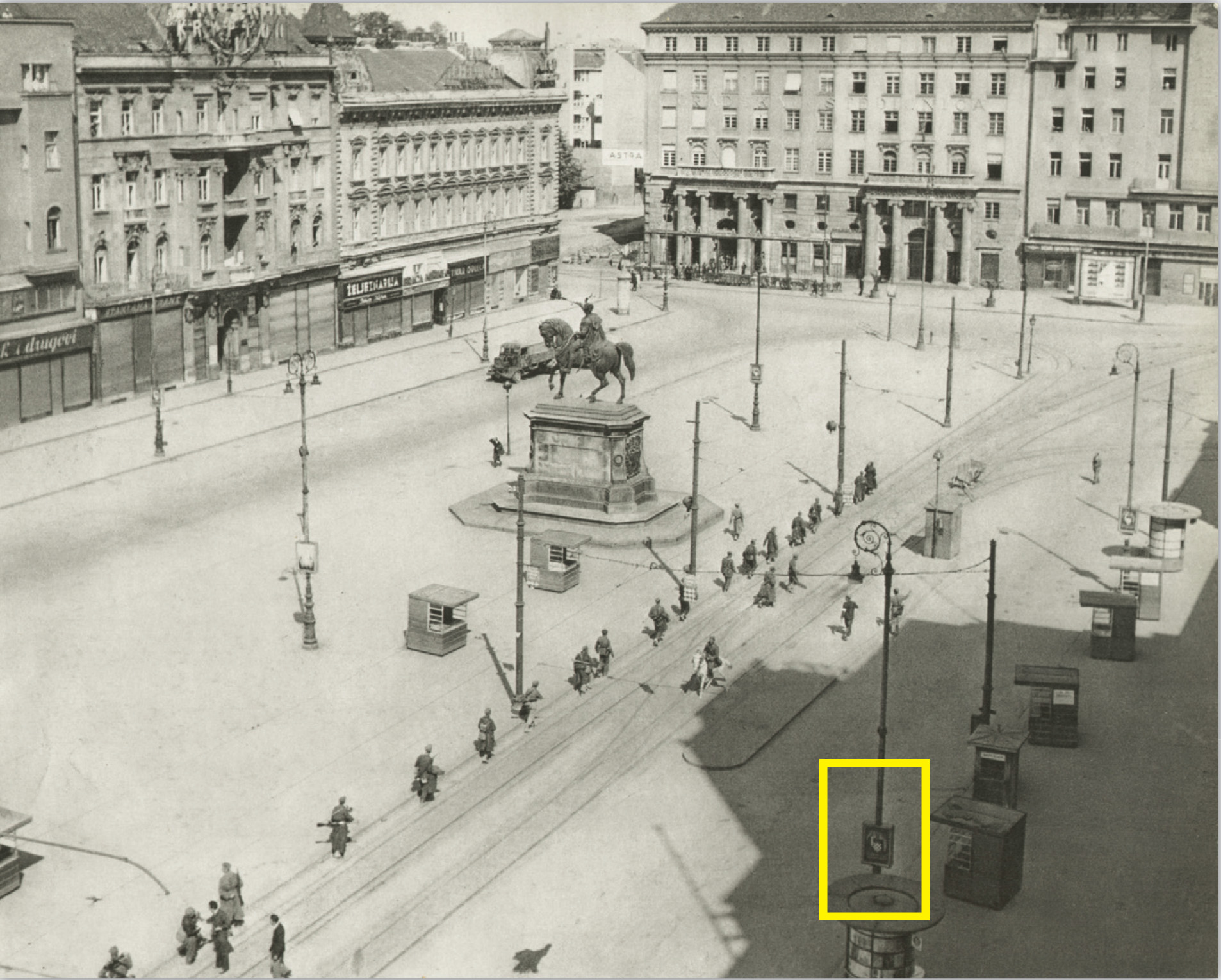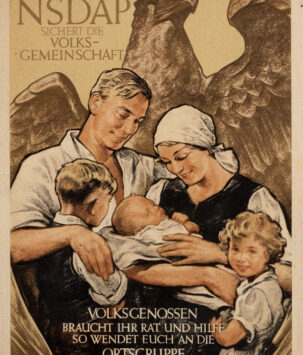Struggle, Independence, Totality
Propaganda poster c. 1944 celebrating the establishment of the Independent State of Croatia (NDH) led by the fascist Ustaše. An ethereal nimbus of light surrounds a king bearing the insignia of the Ustaše. Modern rendition of traditional medieval imagery typical of the era. Such juxtaposition of old and new is integral to fascist philosophy and a common technique utilized in its aesthetic; it is derived from the concept of ‘palingenesis’, meaning the rebirth of a nation with ancestral characteristics. In this instance, the imagery draws a parallel between the unquestionable authority of the Ustaše and the royal authority of the ancient Croatian kings, both as powers considered divinely ordained. The messaging at the bottom extolls Croatia’s national self-actualization through struggle, a dogma no less applicable to man on an individual level.
Croatia was liberated from Yugoslavia by the Axis powers in 1941 in a swift campaign that lasted 2 weeks, and the Independent State of Croatia was thus established as a condominium under German and Italian auspices. The regime was notable for their excessive brutality that managed to appall even the Germans. Military attache Edmund Glaise-Horstenau stated on their conduct:
“I am frequently told that German occupation troops would have to intervene against Ustaše crimes…I saw in the Sava River the corpse of a young woman with her eyes dug out and a stake driven into her sexual parts. This woman was at most twenty years old when she fell into the hands of these monsters. All around, pigs devoured unburied human beings.”
Even the dreaded Gestapo was not sympathetic to this wanton violence, with a 1942 report to Heinrich Himmler reading:
“Increased activity of the partisans is chiefly due to atrocities carried out by Ustaše units in Croatia against the Orthodox population. The Ustaše committed their deeds in a bestial manner not only against males of conscript age, but especially against helpless old people, women and children. The number of the Orthodox that the Croats have massacred and sadistically tortured to death is about three hundred thousand.”
The genocidal campaign against the minority Serbian population was pursued through particularly primitive and barbaric means that made German concentration camps appear comparatively humane. These Croatian counterparts specialized in brutal one-on-one violence that utilized blades and blunt weapons as the primary method of dispatchment. The Ustaše carried out extensive means of torture and sexual crimes towards its inmates unheard of in German camps that included, but were not limited to: inserting hot nails under finger nails, mutilation, plucking out eyeballs, splitting the cranium with tightened chains, administering salt in open wounds and tying inmates in pairs back to back before disemboweling and tossing them into the river alive. Female inmates faced rape as well as the mutilation of their sexual organs.
Further yet, the Ustaše took joy in these atrocities, wearing necklaces of human eyes and tongues removed from their Serb victims. Ustaše commander-in-chief Vjekoslav Luburić states proudly that “We have slaughtered here at Jasenovac [Croatia’s foremost concentration camp] more people than the Ottoman Empire was able to do during its occupation of Europe.”
Second image shows our poster being exhibited at a Croatian state art exposition, while third image shows Yugoslav partisans entering Zagreb in 1945 with the same Ustaše poster still displayed on a lamp post.
Free shipping on orders over $50!
- Satisfaction Guaranteed
- No Hassle Refunds
- Secure Payments
Propaganda poster c. 1944 celebrating the establishment of the Independent State of Croatia (NDH) led by the fascist Ustaše. An ethereal nimbus of light surrounds a king bearing the insignia of the Ustaše. Modern rendition of traditional medieval imagery typical of the era. Such juxtaposition of old and new is integral to fascist philosophy and a common technique utilized in its aesthetic; it is derived from the concept of ‘palingenesis’, meaning the rebirth of a nation with ancestral characteristics. In this instance, the imagery draws a parallel between the unquestionable authority of the Ustaše and the royal authority of the ancient Croatian kings, both as powers considered divinely ordained. The messaging at the bottom extolls Croatia’s national self-actualization through struggle, a dogma no less applicable to man on an individual level.
Croatia was liberated from Yugoslavia by the Axis powers in 1941 in a swift campaign that lasted 2 weeks, and the Independent State of Croatia was thus established as a condominium under German and Italian auspices. The regime was notable for their excessive brutality that managed to appall even the Germans. Military attache Edmund Glaise-Horstenau stated on their conduct:
“I am frequently told that German occupation troops would have to intervene against Ustaše crimes…I saw in the Sava River the corpse of a young woman with her eyes dug out and a stake driven into her sexual parts. This woman was at most twenty years old when she fell into the hands of these monsters. All around, pigs devoured unburied human beings.”
Even the dreaded Gestapo was not sympathetic to this wanton violence, with a 1942 report to Heinrich Himmler reading:
“Increased activity of the partisans is chiefly due to atrocities carried out by Ustaše units in Croatia against the Orthodox population. The Ustaše committed their deeds in a bestial manner not only against males of conscript age, but especially against helpless old people, women and children. The number of the Orthodox that the Croats have massacred and sadistically tortured to death is about three hundred thousand.”
The genocidal campaign against the minority Serbian population was pursued through particularly primitive and barbaric means that made German concentration camps appear comparatively humane. These Croatian counterparts specialized in brutal one-on-one violence that utilized blades and blunt weapons as the primary method of dispatchment. The Ustaše carried out extensive means of torture and sexual crimes towards its inmates unheard of in German camps that included, but were not limited to: inserting hot nails under finger nails, mutilation, plucking out eyeballs, splitting the cranium with tightened chains, administering salt in open wounds and tying inmates in pairs back to back before disemboweling and tossing them into the river alive. Female inmates faced rape as well as the mutilation of their sexual organs.
Further yet, the Ustaše took joy in these atrocities, wearing necklaces of human eyes and tongues removed from their Serb victims. Ustaše commander-in-chief Vjekoslav Luburić states proudly that “We have slaughtered here at Jasenovac [Croatia’s foremost concentration camp] more people than the Ottoman Empire was able to do during its occupation of Europe.”
Second image shows our poster being exhibited at a Croatian state art exposition, while third image shows Yugoslav partisans entering Zagreb in 1945 with the same Ustaše poster still displayed on a lamp post.






